Outdoor Classroom: High Schoolers Get Their Hands on Science
July 25, 2008
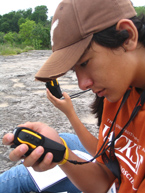
How do you hold the attention of 124 high school students for 5 hours? Oh, and manage to teach them a little science too?
That was the challenge taken up by the staff, alumni and students of the Jackson School of Geosciences one balmy day this past May. Their solution?
First, take them out somewhere scenic with dramatic evidence of volcanism, faulting, hydrology and sedimentary processes—say, McKinney Falls State Park southwest of Austin.
Second, split them up into small groups.
Third, surround them with lots of adults, including veteran geologists, education and outreach specialists, science teachers, parents, and Jackson School staff and undergraduates.
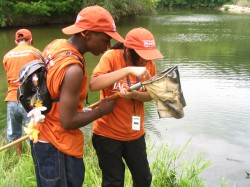
Fourth, keep them moving and keep them busy: Show them how to use a handheld GPS locator to find themselves on an aerial map. Point out how water carves through limestone rock and preferentially nibbles away at ashy layers, creating precarious overhangs. Identify giant fossil clams embedded in rock. Explore a rock shelter used by native Americans thousands of years ago. Encourage them to dig in stream sediment for bugs such as dragonflies and beetles, leeches, crawfish and other little underwater creatures. (Certain “indicator species” give a rough indication of water quality. It also allows students to dig their hands down in rich pungent black mud and even fill a shoe or two with water.)
The students, all freshmen and sophomores, attend Manor New Technology High School just a few miles east of Austin. In fact, nearly the entire school came along for the field trip including several teachers and parents. The school, which has a total of 140 students, has only existed for one year.
Many of the students appreciated the chance to be outdoors for the day and to be challenged to see nature in new ways.
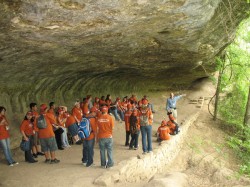
“The part that I liked was when we were talking about the rocks and the GPS, also how old the things were, like a tree—it was 500 years old,” wrote student Yoselyn Banegas-Martinez.
Other highlights students mentioned on their evaluation forms were collecting bugs, learning about water quality, and seeing the effects of processes that happen on geologic time scales such as sedimentation and erosion. Some students wrote that they became more interested in pursuing science in college and in their careers.
The most beneficial part was “being able to converse with some of the student instructors and learn what made them choose geosciences as their field of study,” wrote student James Hutton.
Their high school is one of 35 new Texas Science, Technology, Engineering and Math (T-STEM) academies opening across the state. The T-STEM program was created in 2005 as a public-private partnership to help prepare Texas students for college and the global workplace. The school also acts as a model for other Texas schools through development of curriculum and instructional materials, teacher training, and professional development.
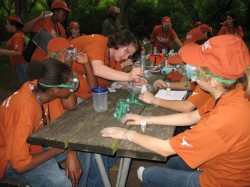
The school promotes project based learning, in which students investigate real world problems, design their own processes of discovery and develop solutions. It differs from a traditional classroom environment in that teachers don’t just feed information to students who passively absorb it. Rather, teachers act as facilitators while students work with a high degree of autonomy.
Jessica Gordon, graduate research assistant for the Jackson School’s outreach programs, organized the trip with help from the school’s staff, students and alumni.
“One of the goals of this project was not just to tell students how it is or how it was but to foster their own thinking like scientists and provide them with the foundation they need to come up with their own conclusions,” said Gordon.
She felt the project achieved its intended goal of providing students with an interdisciplinary field experience that will hopefully increase their interest in science and inspire them to learn more about the word around them.
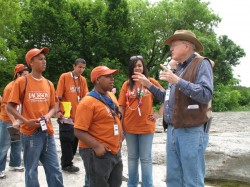
“It was exciting to hear students formulate their theories about why there are bubbles in the water or why their bottle flowed upstream and then making that connection to what they learned in the classroom about photosynthesis or stream flow,” said Gordon.
She also noted that many high schools, under pressure to improve scores on standardized tests, are cutting back on extracurricular activities and field trips.
“I’ve heard field trips described as fluff,” she said. “People will say, ‘We have to get rid of the fluff.’ I think they can be powerful tools to incorporate into the curriculum, especially if you do activities in the school before and after the field trip. Then it becomes a common experience for all the students to talk about biology or chemistry or geology.”
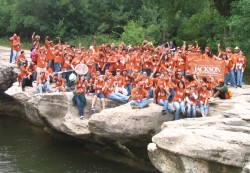
The field trip teamed students up with three veteran geologists—Jim Sansom (the second person to ride a cable down into the newly discovered Inner Space Caverns), Pete Rose (who owns an oil and gas company and once traveled over 100,000 miles in a year for his job), and Chock Woodruff (a man who goes inside dams to see if they are cracking)—plus two geologists who work in outreach and education—Sigrid Clift (the State of Texas public geology information specialist) and Tiffany Hepner (a coastal geologist who teaches high schoolers how to monitor coastal processes).
The field trip was sponsored by the Communities Foundation of Texas, a Dallas-based foundation that supports health, education, cultural and social programs. The grant was made through the foundation’s Texas High School Project Fund.
by Marc Airhart
For more information about the Jackson School contact J.B. Bird at jbird@jsg.utexas.edu, 512-232-9623.
